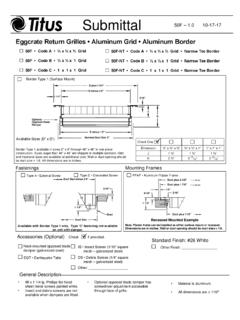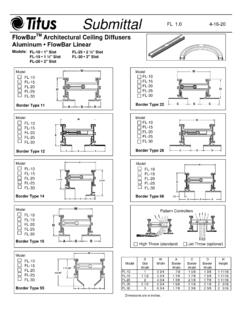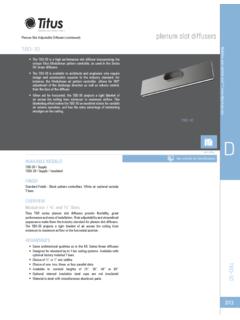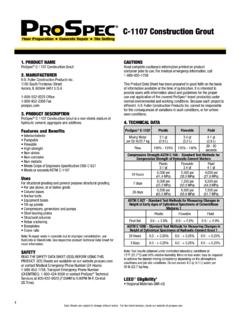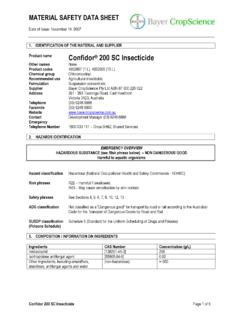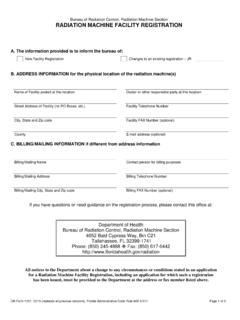Transcription of Air Balancing APPLICATION GUIDE - Titus HVAC
1 APPLICATION GUIDER edefine your comfort zone. | Balancing2 APPLICATION GUIDE - AIR BALANCINGR edefine your comfort zone. | GUIDEAIR BALANCINGT able of ContentsThis document provides general information necessary to balance Titus hvac equipment. Use this document along with the specific product flow factors to balance air distribution information may be found at the Titus website, its address is , the Titus Spiral, and are trademarks of Titus . All other trademarks, noted or not, are the property of their respective ..4 Flow and Pressure Example Air Volume ..4 Example Air Pressure ..4 Example Fan Total Example Fan Volume ..4 Definitions ..5 Anemometer ..5 Area Factor ..5 Velocity ..5 Velometer ..5 Instrumentation ..6 Preliminary Balancing Steps ..6 Proportional Balancing Steps ..7 Grille Free Area ..4 Cross Reference.
2 5 System Balancing Worksheet ..63 APPLICATION GUIDE - AIR BALANCINGR edefine your comfort zone. | intention of an air conditioning engineer is to design an air distribution system to deliver the required air volume to satisfy the space load. The duct system components are sized to deliver air without excessive Balancing . Under ideal conditions, the pressure loss from the fan to the supply outlets should be sufficient to overcome the pressure loss through the supply outlet and distribute the air to the space. This ideal system would require no further airflow adjustments. However, in reality this condition is usually not met. Therefore, the system and component Balancing is required to achieve the engineer s design fans operate at a constant speed they have such characteristics that for a given air flow rate a certain pressure will be developed at the fan discharge.
3 If the pressure requirement changes, the quantity of air delivered will also change. It is important to note that each downstream damper adjustment affects the fan pressure and airflow. An individual outlet cannot be adjusted without affecting the rest of the system. Therefore the system must be balanced in accordance with some systematic procedure. The objective of the manual is to provide a basic understanding of air conditioning system Balancing . The Balancing method presented within this manual uses a velometer positioned by hand at each grille. The method is generally referred to as the Chicago Proportional Balancing GUIDE - AIR BALANCINGR edefine your comfort zone. | GUIDEAIR BALANCINGM ethodologyFigure 1 shows a typical example of a fan and duct system pressure characteristic.
4 The duct system has four supply outlets with a damper in each outlet s branch line. There is also a damper in the main duct between the fan and the first branch takeoff. Each part of the system has the characteristic that the pressure required to overcome the resistance of that section of the system varies as the square of the volume of air flowing through it. Curve A shows the pressure characteristic of the last section of the duct from station 0 to 1, curve B represents the system including the last two supply outlets and so on. The following numerical examples illustrate the relationship between the volume of air flowing through a section of the system and the required pressure to overcome the resistance of that AND PRESSURE REQUIREMENTSThe following are examples of flow and pressure requirements occurring in an air distribution AIR VOLUMEAt the a on the A curve; the required pressure is 1 for 8 units of air volume flow per unit time.
5 When the flow is increased from 8 units at a a to 16 units at b then,16 flow units 8 flow units= 2 and (2)2 = 4 Therefore, the required pressure at point b is1 pressure unit x 4 = 4 pressure unitsEXAMPLE AIR PRESSUREAt the C on the B curve, the required pressure is 2 for 8 units of airflow. When the flow is increased from 8 units at c to 12 units at d then,12 flow units 8 flow units= and ( )2 = , the required pressure at point d is2 pressure units x = pressure unitsExample Fan Total PressureThe following general equation may be used to perform fan pressure , based upon this basic fan law, a 20 percent increase in fan volume requires(1 + )2 = or 44% higher fan total pressureEXAMPLE FAN VOLUMEA nother useful basic fan law is as follows:Fan Vol. Flow2 = Fan Vol. Flow1x (Fan RPM2) (Fan RPM1)Such that a 10 percent increase in fan volume requires a 10 percent increase in fan 1.
6 Fan and System Characteristics5 APPLICATION GUIDE - AIR BALANCINGR edefine your comfort zone. | used for determining the force or speed of air. Two anemometer types are as follows: Vane: Used to measure sidewalls, grilles, registers, and ceiling diffusers. The vane anemometers are commonly depicted with Balancing Titus air system equipment. Rotating vane: Used to measure linear feet of air passing through it. Generally used for measuring air velocity through supply, return and exhaust air grilles, registers, or openings. Do not use a rotating vane anemometer as an averaging FactorThe area factor, AK, is the effective area of the outlet at the point of outlet velocity, the VK measurement is such that the volume flow is equal to AK times area factors are based on equalized airflow 12 flow units in the outlet : Severe damper throttling or takeoffs without air turning devices or control grids can affect the indicated airflow accuracy of these factors measurement of air speed as it exits the grille, register, or diffuser.
7 Velocity is averaged by number of readings taken at grille, register, or diffuser. Velocity is measured with instruments and depending on APPLICATION , the velocity being measured can be either supply or return used for hvac Balancing , static pressure measurements, energy GUIDE - AIR BALANCINGR edefine your comfort zone. | GUIDEAIR BALANCINGI nstrumentationPreliminary Balancing StepsWe recommend all system Balancing instruments calibrated annually with the manufacturer s furnished calibration curve. Also, it is strongly recommended these instruments be used within their specified accuracy range. The appropriate usage and accurate instrument calibration ensures ongoing credibility and accuracy for the air Balancing return grille Balancing , the position of the velometer probe must be as shown in the diagrams for each diffuser shown.
8 Based on the vane anemometer use, the attachment of the tubing to the anemometer requires a reversing movement on the instrument. Alternative methods may use a flow hood in a similar manner. Consult organizations such as NEBB and AADC for more information on those methods that use the flow hood to measure volume flow the following information to Balancing Open all system air valves and dampers in both supply and return Set all other dampers to normal operating Check all filters and coils to ensure they are clear of dirt and Start all Check rotation of all fans and ensure the direction is Copy the Balancing worksheet provided in this manual to record Number the outlets on the : The furthest branch and the furthest outlet on the branch away from the fan will be outlet one on the branch number one. The outlets are numbered consecutively working back toward the fan.
9 Figure 2 shows the numbering is very important the outlets be numbered, tested, and adjusted in the described sequence. If the sequence is not followed, the procedure will not be Spot-check outlets along the branch to determine if enough air is being delivered to give measurable 2. Schematic Diagram of the Duct System7 APPLICATION GUIDE - AIR BALANCINGR edefine your comfort zone. | Balancing StepsThe following Balancing information is specific to low pressure ventilating and air conditioning Measure velocities at Outlet 1, the furthest outlet on the Determine the average velocity and use the System Balancing Worksheet to record the value in the column VM (measured velocity) under Adjustments I heading. This indicates the first reading of that Determine the ratio of VD (measure to design velocity) and record R (ratio) under Adjustment I and 1B.
10 Use the following equation to determine = Measured Velocity VM AK (flow factor)= VD4. Proceed to the second outlet. Determine the average velocity (VM) and ratio (R) and record these values under Adjustment I and Compare R values from 1B and 2A under Adjustment I. If the R values are not equal, adjust Outlet 2 so R2 will approach R1. Do not adjust Outlet After adjustment, record VM and R values for Outlet 2 under II and Go back to Outlet 1 and measure VM. Record VM and R values under Adjustment II, 1B. If R values shown under adjustment II, 1B and 2A vary more than , they are not proportionally balanced one to another and further adjustment to Outlet 2 is required. After each adjustment of outlet number, record the new VM and R values under 1B and 2A in each successive adjustment column.




